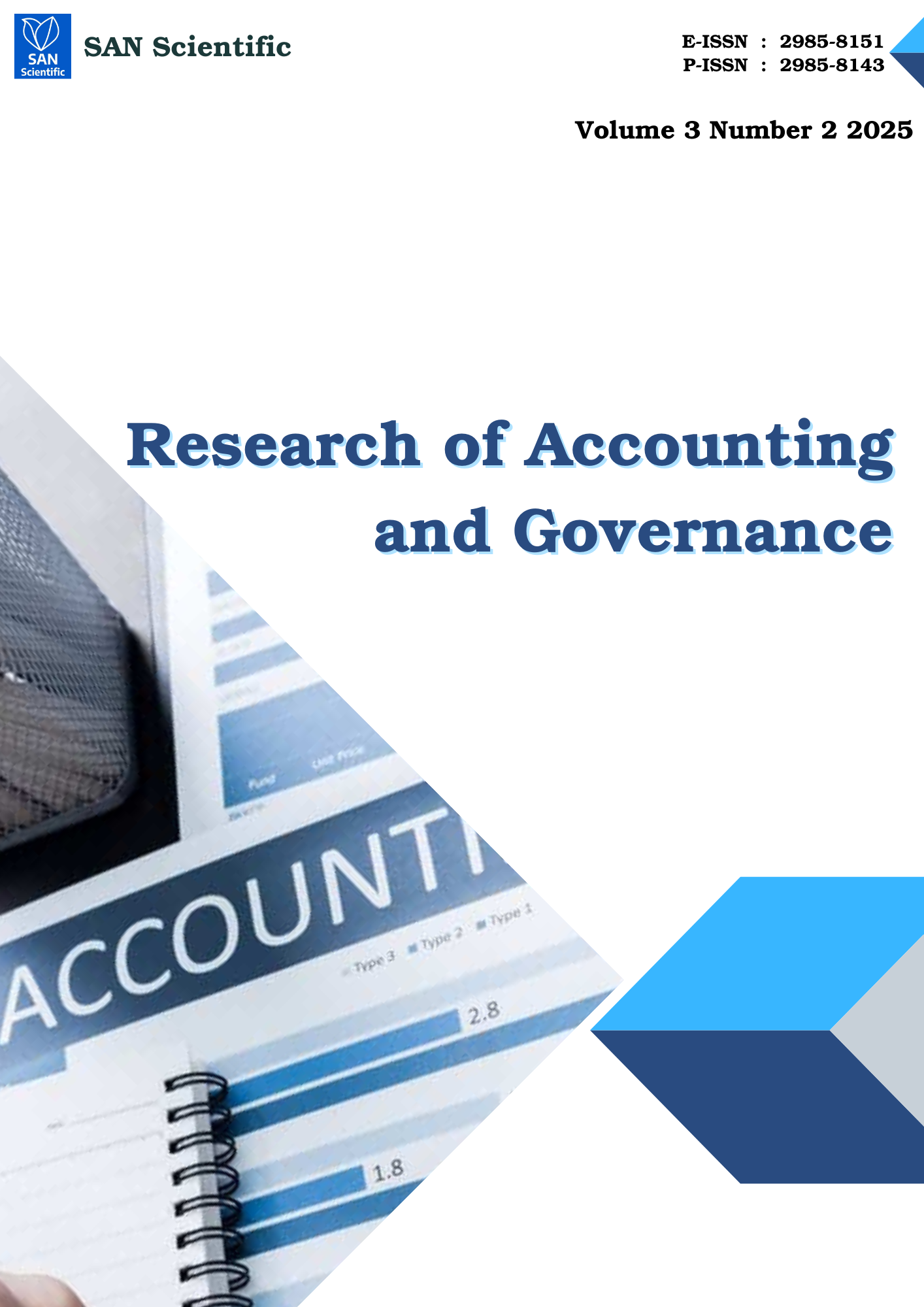Exchange Rate and Macroeconomic Impacts on Indonesia’s Balance of Payments
DOI:
https://doi.org/10.58777/rag.v3i2.461Keywords:
Balance of Payments, Exchange Rate, Reference Coal Price, Foreign Exchange Reserves, Gross Domestic ProductAbstract
Indonesia, as a nation that heavily relies on commodity exports, experiences notable impacts from exchange rate fluctuations in its efforts to maintain a stable balance of payments (BOP). This study seeks to analyze the influence of several macroeconomic variables specifically, the exchange rate, reference coal price (HBA), foreign exchange reserves, and gross domestic product (GDP) on Indonesia's balance of payments, particularly within the timeframe of 2013 to 2024. The research delves into the external economic vulnerabilities faced by Indonesia in light of global coal price dynamics and currency volatility. Utilizing a quantitative methodology, the study employs multiple linear regression analysis facilitated by EViews and Jamovi software, relying on time series data sourced from credible national and international sources. The findings indicate that, out of the four independent variables examined, only foreign exchange reserves demonstrate a statistically significant and positive impact on the balance of payments, underscoring their vital role in stabilizing the external sector. Conversely, the exchange rate, coal price, and GDP do not reveal significant individual effects. This research offers original insights into the stabilization of macroeconomic conditions in commodity-dependent economies and emphasizes the importance of strategic reserve management in mitigating balance of payments instability.
References
Aizenman, J., & Lee, J. (2007). International reserves: Precautionary versus mercantilist views, theory and evidence. Open Economies Review, 18(2), 191–214. https://doi.org/10.1007/s11079-007-9010-8
Antara News. (2024). BI: RI balance of payments surplus of 7.2 billion US dollars in 2024. https://www.antaranews.com
Apriadi, I., Sembel, R., Santosa, P. W., & Firdaus, M. (2017). Kompetisi dan Stabilitas Perbankan di Indonesia: Suatu Pendekatan Analisis Panel Vector Autoregression. Jurnal Manajemen, 21(1), 33. https://doi.org/10.24912/jm.v21i1.146
Badarasyid, A. I., & Setiawati, R. I. S. (2023). Analysis of the influence of exchange rates, inflation and reference coal prices on Indonesian coal exports to China. PROMOSI: Journal of the Economic Education Study Program (e-Journal), 11(1), 23–33. https://doi.org/10.xxxxxx/promosi.v11i1.1234
Bank Indonesia. (n.d.-a). JISDOR exchange rate information. https://www.bi.go.id/en/statistik/informasi-kurs/jisdor/Default.aspx
Bank Indonesia. (n.d.-b). Indonesian Economic and Financial Statistics (SEKI). https://www.bi.go.id/en/statistik/seki/Default.aspx
Central Bureau of Statistics. (n.d.-a). Indonesian exchange rate 2013–2024. https://www.bps.go.id
Central Bureau of Statistics. (n.d.-b). Quarterly balance of payments. https://www.bps.go.id
Choudhri, E. U., & Hakura, D. S. (2015). The exchange rate pass-through to import and export prices: The role of nominal rigidities and currency choice. Journal of International Economics, 96(1), 60–77. https://doi.org/10.1016/j.jinteco.2015.01.002
Coordinating Ministry for Economic Affairs. (2024). Indonesia’s balance of payments experiences surplus, signaling maintained external resilience stability. https://www.ekon.go.id
Ghozali, I. (2011). Aplikasi analisis multivariate dengan program SPSS (5th ed.). Semarang: Badan Penerbit Universitas Diponegoro.
Ginting, E. (2013). Pengaruh nilai tukar terhadap kinerja ekonomi eksternal. Jurnal Ekonomi dan Keuangan, 20(1), 45–58.
International Energy Agency. (2023). Coal 2023: Analysis and forecast to 2028. https://www.iea.org/reports/coal-2023
Khair, A., Lestari, W. I., & Batubara, M. (2024). The decline in the rupiah exchange rate against the dollar. Journal of Multidisciplinary Studies, 8(6), 100–112.
Krugman, P., & Obstfeld, M. (2018). International economics: Theory and policy (11th ed.). Pearson.
Latifah, N., & Michael, A. (2022). The Balance of Payments and the Exchange Rate: An Indonesian Case. Jurnal Ekonomi Pembangunan Indonesia, 10(2), 112–123.
Liputan6.com. (2024). Indonesia is expected to have a balance of payments surplus of USD 7.9 billion by the end of 2024. https://www.liputan6.com
Maulana, A., & Huda, S. (2020). Marshall-Lerner condition and trade balance dynamics: Evidence from Indonesia. Jurnal Ilmu Ekonomi dan Studi Pembangunan, 7(1), 45–58.
Ministry of Energy and Mineral Resources. (n.d.). Reference coal price. https://minerba.esdm.go.id
Obstfeld, M., Shambaugh, J. C., & Taylor, A. M. (2010). Financial Stability, the Trilemma, and International Reserves. American Economic Journal: Macroeconomics, 2(2), 57–94. https://doi.org/10.1257/mac.2.2.57
Pasuria, S., & Triwahyuningtyas, N. (2022). The Influence of Labor Force, Education, Minimum Wage, and Gross Domestic Product on Unemployment in Indonesia. SIBATIK Journal: Scientific Journal in Social, Economic, Cultural, Technology, and Education, 1(6), 795–808. https://doi.org/10.57016/sibatik.v1i6.123
Senen, A. S., Kumaat, R. J., & Mandeij, D. (2020). Analysis of the influence of the rupiah exchange rate, Bank Indonesia's benchmark interest rate and foreign exchange reserves on inflation in Indonesia for the period 2008:Q1–2018:Q4. Scientific Periodical Journal of Efficiency, 20(1), 30–42.
Samsudin, I., Sihombing, P., & Kwee, Y. H. (2024). Determinants of the Developed Country Index and Indonesian Macroeconomic on the IDX Growth 30 and IDX Value 30. Research of Economics and Business, 2(2), 78–93. https://doi.org/10.58777/reb.v2i2.209
Sihombing, P., Pranata, N., & Kwee, Y. (2024). Effect of Dividend, Profitability, and Interest Rates on Firm Value with Leverage as Moderating. Research of Finance and Banking, 2(1), 14–24. https://doi.org/10.58777/rfb.v2i1.218
Sihombing, P., & Priambhodo, Y. D. (2024). The Effect of Coal Production, Profitability, Leverage, Newcastle Price on Firm Value with Renewable Energy Moderation. Research of Economics and Business, 2(1), 25–38. https://doi.org/10.58777/reb.v2i1.203
Yustika, A. E. (2016). Ekonomi kelembagaan: Definisi, teori dan strategi. Jakarta: Erlangga.
Downloads
Published
How to Cite
Issue
Section
Copyright (c) 2025 Zhafirah Kirana Zahra, Tia Yuniarsih, Raisa Hasna Nabila Proboputri, Reksa Akbar Maulana, Ahmad Setiawan Nuaraya

This work is licensed under a CC Attribution-ShareAlike 4.0
 Views: 83
|
Views: 83
|
 Downloaded: 46
Downloaded: 46











